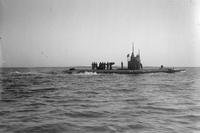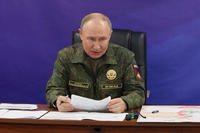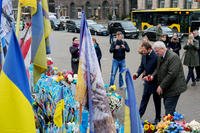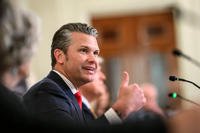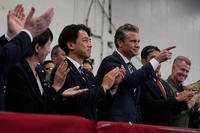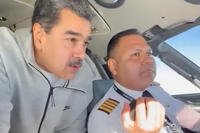In the wake of the Second World War, 12 countries from Europe and North America banded together to form an alliance that would keep the hard-won peace in Europe, promote cooperation between them and protect their freedoms. They would need the new NATO alliance for the Cold War that was soon to come.
The Eastern Bloc responded by forming its own alliance, the Warsaw Pact, a similar mutual defense treaty between eight newly formed communist countries. But before that treaty was signed, the Soviet Union did something that seems bizarre by today's standards: It requested to join NATO.
Open contempt between East and West didn't begin right after World War II, but animosity was brewing almost immediately. The USSR had a massive number of troops deployed across Europe by the end of the war, but that might was checked by American nuclear weapons, which President Harry Truman would use to pressure the Soviets.
The wartime Allies began butting heads over how to rebuild postwar Europe. The United States was flooding Western Europe with money from the Marshall Plan, rebuilding the countries of the West into free, democratic societies. Meanwhile, the Soviet Union was rebuilding its occupied territories in its own image, repressive communist governments with command economies.
Most importantly, the USSR was extracting the wealth and resources of those countries, seizing billions of dollars as war reparations to recover from the war's effects at home. It used puppet regimes, local communist parties that took orders from Moscow.

Fearing everything from the encroachment of communist regimes to an outright Soviet invasion of Western Europe, the Western powers signed a number of mutual defense treaties and created many treaty organizations to rally European countries to the anti-Soviet cause. The enduring alliance was NATO, with 12 founding members, which included the U.S. and Canada.
The treaty was signed after a communist coup in Czechoslovakia ousted the democratically elected government. It also pushed for acceptance of the Marshall Plan, the formation of West Germany and the forceful measures taken in the West to keep communists out of government.
Joseph Stalin was particularly afraid of a reconstituted Germany allied with the West, while the West wanted the military potential of West Germany in its alliance. The outbreak of the Korean War in 1950 accelerated the creation of NATO's military structure, led by a civilian secretary general.
The Korean War ended and Stalin died in 1953, but the death of Stalin did nothing to calm the fears of a Soviet invasion or end Moscow's fear of a rearmed Germany. At the Berlin Conference in 1954, Soviet Foreign Minister Vyacheslav Molotov proposed that Germany be reunified, demilitarized and allowed to determine its own economic system.
The West, believing the proposal was a bluff, demanded Germany be allowed to rearm and join a European defense organization. When that counterproposal was rejected, the Soviets proposed creating a pan-European security apparatus, which excluded the United States. The West rejected that offer.
In March 1954, the Soviets then sent the Western allies a proposal for the USSR to join NATO. In a letter to Georgy Malenkov, then the USSR's head of state, and Communist Party General Secretary Nikita Khrushchev, Molotov laid out the benefits of joining the North Atlantic Pact.
He wrote the action "would make things difficult for the organizers of the North Atlantic bloc and would emphasize its supposedly defensive character, so that it would not be directed against the USSR."
Molotov wanted to join NATO because it would end the proposed anti-Soviet European Defense Community (a treaty that was never ratified) while undermining the planned rearmament of West Germany. It would also have forced the bulk of American military forces and bases to leave Europe.
Fortunately, NATO rejected the proposal because "the USSR's membership of the organization would be incompatible with its democratic and defensive aims." West Germany eventually rearmed and joined NATO in 1955, which led to the formation of the Warsaw Pact, the Soviets' own defensive alliance.
-- Blake Stilwell can be reached at blake.stilwell@military.com. He can also be found on Twitter @blakestilwell or on LinkedIn.
Want to Learn More About Military Life?
Whether you're thinking of joining the military, looking for post-military careers or keeping up with military life and benefits, Military.com has you covered. Subscribe to Military.com to have military news, updates and resources delivered directly to your inbox.


